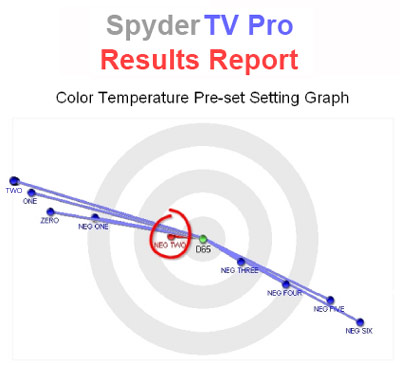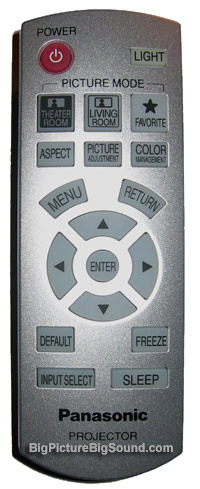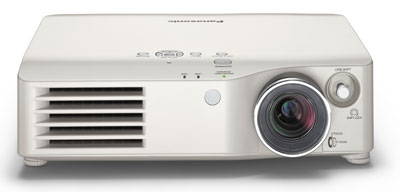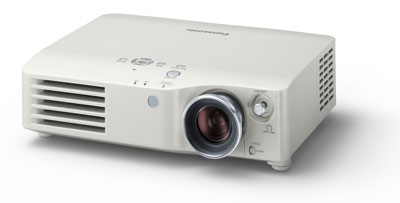Panasonic PT-AX100U LCD Home Theater Projector Review
By Joe Lozito
Panasonic: Ideas for Light?
Right out of the box, the first thing I noticed about the
Panasonic is its size. This isn't a small projector. Not overly beefy, mind you, just a bit larger than what I'm used to. The
PT-AX100U weighs in at 10.8 lbs with a HxWxD of 4.4 x 15.5 x 11.8. This is about 2 lbs heavier and a full inch larger on each side than my current reference projector, the Sanyo PLV-Z2. However, from what we've seen lately, a move towards this size and weight appears to be becoming a standard for projectors in this class.
With its powerful 2X zoom lens, the AX100U is said to throw a 100" diagonal image anywhere from 10 to 20 feet. In our screening room, with a 12' throw distance and a 98" diagonal screen, the Panasonic fit in perfectly. The vertical lens shift also allowed us to adjust the image properly without digital keystoning. But sadly, the Panasonic's horizontal lens shift capabilities left a bit to be desired. While the Sanyo can shift a full 50% up/down and left/right, the Panasonic was only able to adjust about half that in the horizontal domain, which required moving some mounting hardware in order to get a geometrically correct image. Of course, a more central horizontal mounting location (even a bit off center) would obviate this problem.
A quick turn on
I'm used to a projector taking its own sweet time to warm up, but here the Panasonic wasn't kidding around: it has a warm-up time of about 20 seconds, rather than the typical 30. The Panny's fan, however, is not as quiet as I'd like. I wouldn't call the AX100U "loud," but it's definitely there and it's significantly less quiet than the Z2.
With a Panasonic, Always Bet on Black
Panasonic's reputation for deep blacks preceded it, so I was anxious to put the AX100U to the test. Right out of the box, the black levels were some of the best I've seen. The picture itself - with an HD signal, of course - was crisp and beautiful. Panasonic's "Smoothscreen" technology is said to all but eliminate annoying pixilation. I certainly found that to be true of pure HD signals.
I integrated the AX100U into my system via both component video and HDMI cables, just to see the difference. Though both component video and HDMI connections produced pristine images, the HDMI signal was noticeably smoother when displaying an HD signal. I'm not certain if that's a function of the AX100U's "Smoothscreen" technology or simply due to keeping the video signal in the digital domain from source to projector, but there was a noticeable improvement in the HDMI feed.
Happily, my cable provider was on a roll and I was able to test some great HD broadcasts on the AX100U. "Saving Private Ryan" and "Jarhead," for example, were beautiful. Their supersaturated images were nearly tactile. Other (non-movie) HD content was also remarkably vivid. The Panasonic might turn me into a soccer fan since it's possible to pick out the facial expressions of individual players with this machine. Also, HD travel shows like "Discover: Italy," when viewed through the AX100, could actually make buying a plane ticket obsolete.
Naturally, I threw in a few of my standard benchmark DVDs ("The Fifth Element," "The Matrix," and most recently "
King Kong)" but, somehow, these images didn't look quite as good. The Panasonic's picture is so pristine it almost
requires an HD signal or a high quality outboard video scaler. I could pick out artifacts in these DVDs that I hadn't seen before. I can't fault the Panasonic for this too much, though. It's like getting any other good component: it makes you want to upgrade your current system. Looks like it's time for an HD-DVD or Blu-Ray Disc player, or at least a good upconverting DVD player.
When it came to watching standard definition TV, however, I nearly had to pull an Oedipus and tear my eyes out. After experiencing the joy of the full HD signal, the SD images looked down right blurry and took some getting used to. The HDMI signal was particularly pixilated with an SD signal. Bottom line - you'll definitely appreciate high quality high definition programming on this projector.
Spyder, man
If the Panasonic looked this good right out of the box, how would it look calibrated? So, with bated breath, it was time to get our calibration on. To this end, we used the
SpyderTV Pro calibration software and colorimeter to set the color, brightness, tint contrast and gamma levels, and used the AVIA Guide to Home Theater disc, to set sharpness and to double-check our other calibration settings by eye.
After running through the full series of video adjustments, we ended up reducing the overall brightness by 16 and color by 10, and increasing contrast by 7. The Panasonic's setup menu offers exceptional control of video settings for the advanced end user or hobbyist, including fine control of R/G/B gamma settings. These individual settings took a moment to decipher (R/G/B "brightness" corresponds to "cuts" in SpyderTV Pro, while R/G/B "contrast" corresponds to "gains"). But in the end, the gamma settings required very little tweaking in order to approach ideal color balance (only the blue gain needed to be reduced to -2, and the red gain increased to +1).

Our SpyderTV Pro calibration software and colorimeter identified the "-2" color temperature setting as the closest to 6500°. With slight adjustments to red and blue gain, you can get even closer.
Once the calibration was complete, the Panasonic's picture was nothing short of breathtaking. The calibrated picture blew any of the factory presets out of the water. The depth and crispness of the HD image was as good as any projector I've seen in our labs.
Bright Lights, Bright…Panny?
The Panny's 2,000 ANSI lumens make it one of the brightest contenders among the competition - a veritable "light cannon." This will make a difference if you like to occasionally enjoy your projector in less-than-ideal lighting conditions (and who doesn't?). I was very excited to try the 100's Light Harmonizer technology, which promises to adjust the brightness of the image based on the ambient light in the room. This feature comes in particularly handy if you have trouble achieving complete darkness in your screening room.
For me, the test was simple: at about midday, I'd close my blackout shades and turn on the Panny. Ah, there's that crisp beautiful image. Then (I could hear the drumroll in the back of my head), I'd hit the button to open the shades. As light filled the room, I was reminded of the last scene of "Nosferatu." Happily, neither I nor the projector's image were destroyed by the light now streaming into the room. The projector automatically adjusted brightness and contrast for the increased light subtly but noticeably.
Obviously, if you've got a lot of direct sunlight spilling onto your screen, the Light Harmonizer isn't going to be able to fully compensate. But for that excess mid-afternoon ambient light, it does make a difference. And if, for example, you're watching a late afternoon football game in beautiful high-definition, it's handy to have the projector adjust itself (via the "electric eye" on the top of the unit) as the sun sets, rather than having to mess with the menus to achieve the same result. Naturally, the Light Harmonizer feature can be turned off if you aren't happy with the results.

The PT-AX100U's remote features easy access to commonly used features, as well as a handy backlight. Just watch out for that "default" button!
This Panny does Windows
With a native resolution of 1280x720 pixels, the Panasonic was also fantastic for projecting my Windows XP PC, though it seems like a waste for such a powerful machine. Still, compared to the washed out display I'm used to with a computer feed on the Z2, the AX100U made my even the most banal activities (photo screensaver anyone?) into mini-events.
Remotely Entertaining
A quick note on the Panasonic's remote: it's great. If I didn't already have my projector controls programmed into my beloved Harmony 890, I'd be happy to use the AX100U's remote to control this projector. Its buttons are intuitively organized, it's friendly to the touch and it has a handy backlight for those dark theater conditions. The only thing lacking is direct input selection buttons for each source but this is a minor gripe.
One caution though: be careful of the "DEFAULT" button on the remote since it has a tendency to reset your unsaved video settings (!). Be sure to save your carefully obtained calibration settings into one of the programmable User Settings before you move on (on this matter, we speak from experience).
Final Thoughts
The Panasonic PT-AX100U's $2,999 price tag is a bit hefty (much like the projector itself) but its "street price" is appreciably lower, so it still offers excellent value for an HD-compatible (720p) LCD projector. Older models of the Panasonic had a rear exhaust, which could be problematic for users who abut their projectors to the rear wall, but the PT-AX100U features a front exhaust as well as air intakes on both the side and rear, so placement is now much more flexible.
The projector's slightly audible fan noise and limited lens shift range may be an issue for some, depending on the layout of your screening room, but these are nitpicks for a projector that gives you such picture-perfect image quality. If you can mount this unit on the ceiling or high on the rear wall fairly close to the center axis of projection (and not too close to your ears), then even these nitpicks become moot, making this a 4-star projector. Its best-in-class 2000 ANSI Lumens brightness makes the projector more versatile than most, allowing you to enjoy breathtaking images even in average room lighting.
Also, if you're using a high quality upconverting DVD player or external scaler for SD material, then the performance you'll see on standard def material will more closely approximate the outstanding image quality you get with HD material.
If you have the means and the space, the AX100U is well worthy of your consideration. But be warned: you may never leave the house again.
Specifications from the Manufacturer
Brightness (Lumens): 2000 ANSI
Contrast: 6000:1
MSRP: $2999
Weight: 10.8 lbs.
Size (inches) (HxWxD): 4.4 x 15.5 x 11.8
Zoom: Manual, 2.00:1
Throw Dist (feet): 7.9 - 20.3
Image Size (inches): 40.0 - 200.0
Keystone Correction: Digital
Lens Shift: Horizontal + Vertical
Warranty: 1 Year
Compatibility:
HDTV: 720p, 1080i, 1080p/60,1080p/24, 1080p/50, 525i, 525p, 576i, 576p, 625i, 625p, 1125i
EDTV/480p: Yes
SDTV/480i: Yes
Component Video: Yes
Video: Yes
Digital Input: HDMI (HDCP)
Personal Computers: Yes
Manufacturer's Contact Information
Panasonic Corporation of North America
One Panasonic Way
Secaucus, NJ 07094
website:
www.panasonic.com



